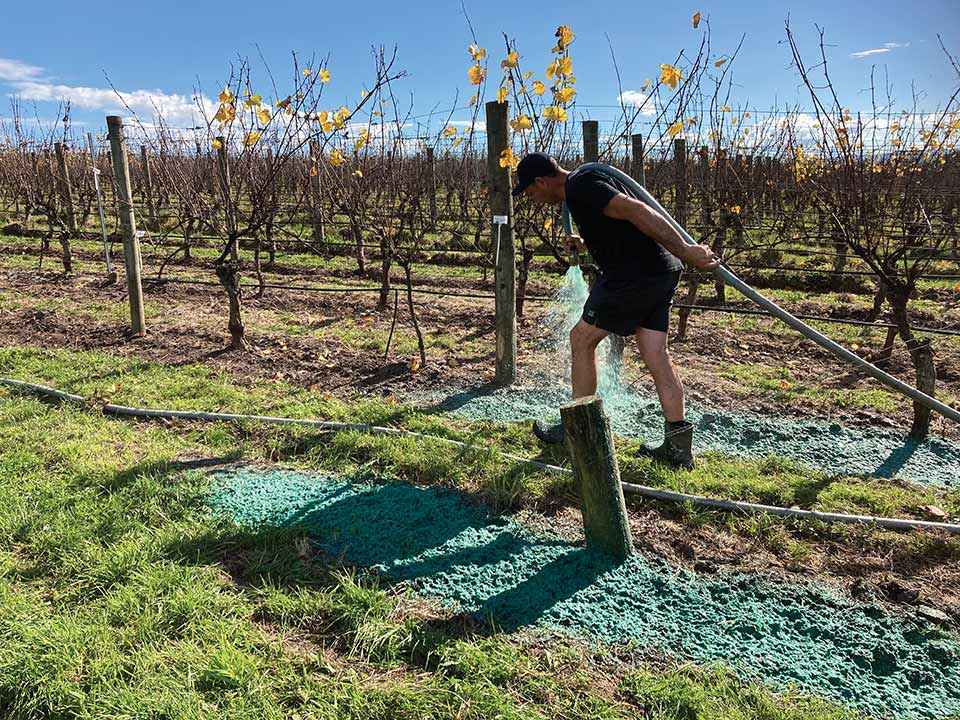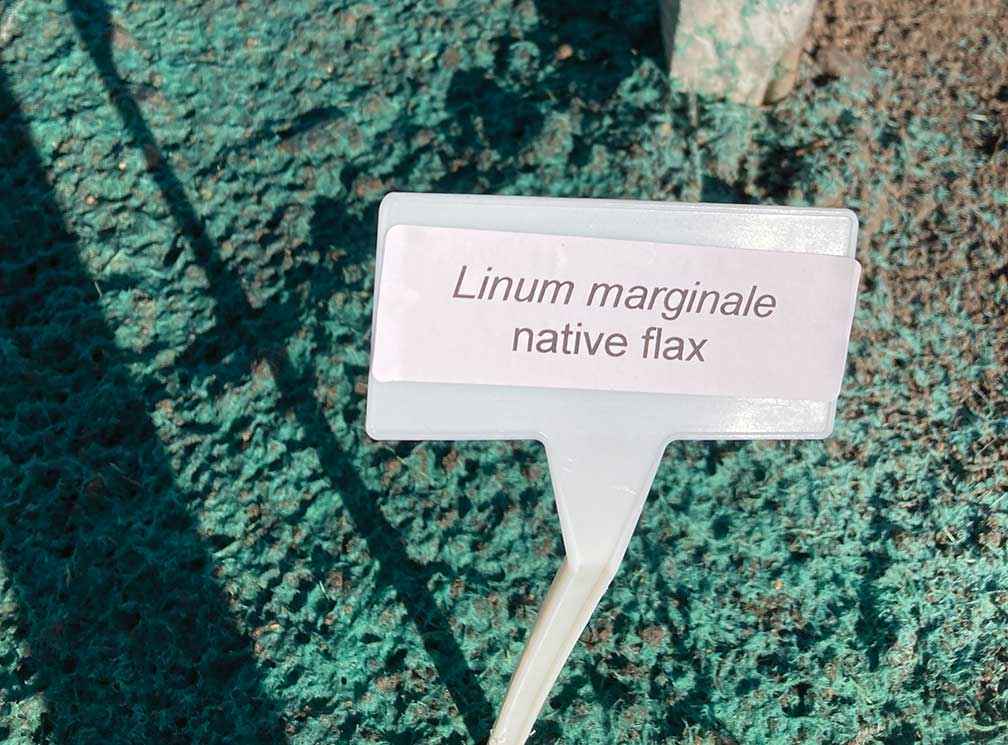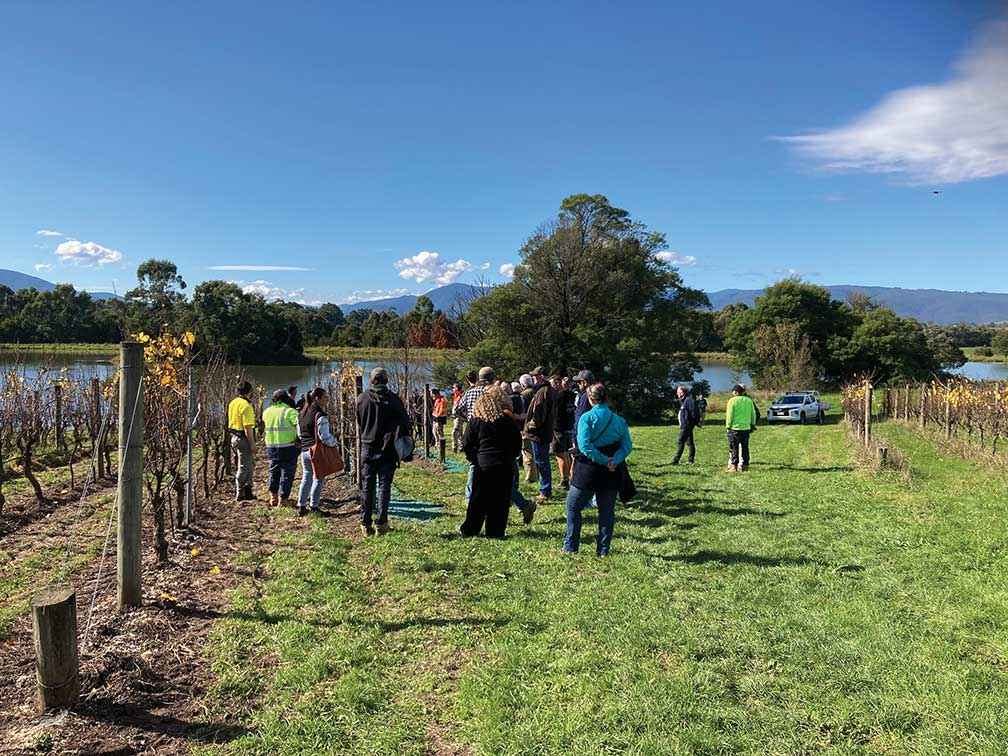Victorian Landcare Magazine - , Issue 89

Winegrape growers are planting a diverse mix of low-growing native ground covers to improve the functional capacity, resilience, and profitability of their vineyards. Growers are being supported in their actions to enhance soil health, establish ground cover, and increase functional biodiversity in vineyards through the National EcoVineyards Program.
The program aims to accelerate the adoption and practice change outcomes specified in Wine Australia’s Strategic Plan 2020–2025, with the aim of increasing the land area dedicated to enhancing functional biodiversity by 10 per cent, and the use of vineyard cover crops and soil remediation practices, also by 10 per cent.
Eight participating wine regions throughout Australia, including Hunter Valley, Orange, Margaret River, Yarra Valley, Mornington Peninsula, Clare, Adelaide Hills, and Langhorne Creek have set up local demonstration sites to trial innovations that support the sector to adopt practices to meet these strategic targets.
Growers are encouraged to achieve 100 per cent functional plant cover and active root growth, for 100 per cent of the time, where possible.
Agricultural practices that create bare soil invite weedy species, also known as pioneer plants or early colonisers, to establish. These plants are often indicators of soil health problems. Early coloniser species include plants that reproduce by spores instead of flowers or seeds, including moss and lichen. These plants help to protect the soil surface when it is sterile often due to prolonged herbicide application.
Growers are encouraged to achieve 100 per cent functional plant cover and active root growth, for 100 per cent of the time, where possible.
Using herbicides in a vineyard is often problematic, with many weedy species quickly becoming herbicide resistant. Growers assume that weeds are directly competing with vines for nutrients, but there can be other factors involved. Some plants release chemicals into the soil which suppress the growth of nearby plants.

Above: Native flax sown under vines with hydromulch to the left and surface seed on the right at the hydroseed trials on the Mornington Peninsula.
By replacing these voids with a diversity of functional ground cover plants, which might include native grasses, forbs (flowering plants) and low growing, prostrate woody plants we can break the cycle of intervention with herbicides. This is the first step in converting compacted and bacteria dominant soil to:
• Be more friable with greater water-holding capacity;
• Have more soil carbon and microbial activity with fungal-dominated soil, which is preferred by perennial species such as grapevines;
• Transform nutrients into plant-available forms;
• Create pathogen-suppressive soil; and
• Have greater resilience in the system.
It is important to maximise the benefits gained from fully utilising nature’s solar panels – the leaves of optimally photosynthesising plants. Photosynthesis and the liquid carbon pathway are considered the most important drivers for building soil.

Above: Wine growers from the Yarra Valley at the hydroseeding demonstration in May 2024.
The liquid carbon pathway is a symbiotic relationship between mycorrhizal fungi and 90 per cent of all plants, including grapevines. Plants will purposely produce extra simple plant sugars and then exude that surplus into the soil to feed and farm fungi. Arbuscular mycorrhizal fungi, a type of fungi that penetrates the cells and roots of vascular plants, in turn, use the exudates to create a sticky carbon exudate called glomalin.
Glomalin is critical when soil aggregates are forming to create soil structures with adequate pores for air and water storage. With the increased water-holding capacity that comes with increased soil carbon, a plant’s photosynthetic capacity increases. This leads to more carbon being pumped into the soil – an important feedback loop – all fuelled by the sun.
In return for these exudates, soil biology, particularly fungi, provides moisture and nutrients back to plants. When the cycle is functioning well, soil biology sources, cycles and transports nutrients that plants require for growth. Without this plant-biology interaction, many minerals and trace elements are not available to plants, so the system doesn’t work optimally.
The National EcoVineyards Program’s ground cover and hydroseeding events held at the Yarra Valley and on the Mornington Peninsula in May 2024 focused on perennial native ground cover species that can break the cycle of intervention and provide long-lasting benefits in vineyards.
We explored the use of a range of low-growing species that might be suitable in the under-vine area by hand-sowing individual species in each panel. Wood fibre mulch was then hydroseeded over the top of half the row so that we can assess germination rates (with and without wood fibre mulch), and the overall success and growth characteristics of each species.
Commercially, a single blend of seed would normally be incorporated in the hydroseeding mix in a single pass.
The native Victorian groundcover species selected for the trials were chosen on availability of seed and their functional purpose for groundcover and attracting beneficial insects. The demonstration sites will provide insights into which species are likely to grow well so regionally specific mixes can be developed. The findings will be presented in each region with a series of case studies in 2025.
The National EcoVineyards Program is funded by Wine Australia with levies from Australia’s grape growers and winemakers and matching funds from the Australian Government.
Dr Mary Retallack delivers the National EcoVineyards Program with support in Victoria from Wine Yarra Valley, Mornington Peninsula Wine, and Melbourne Water. Karen Thomas is Sustainable Agriculture Facilitator at Melbourne Water. For more information go to www.ecovineyards.com.au
Demonstration sites at Chandon in the Yarra Valley and Quealy Wines in Balnarring are testing the following native species:
Tom thumb (Dichondra repens)
Swamp daisy (Brachyscome basaltica)
Fuzzy and woolly New Holland daisy (Vittadinia cuneate and gracilis)
Native flax (Linum marginale)
Billy buttons (Pycnosorus globosus)
Common everlasting (Chrysocehalum apiculatum)
Lemon beauty heads (Calocephalus citreus)
Native blue bell (Whalenbergia strictum)
Native parsnip (Trachymene composite)
Kneed wallaby grass (Rytidosperma geniculatum)
Weeping grass (Microlaena stipoides)
Windmill grass (Chloris truncate)
Creeping saltbush (Atriplex semibaccata)
Inland pigface (Carpobrotus modestus)
Round leaved pigface (Disphyma crassifolium)
Scaly buttons (Leptorhynchos squamatus)
Pussy tails (Ptilotus spathulatus)
A mix of native grasses
A mix of native grasses and forbs